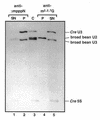Molecular characterization at the RNA and gene levels of U3 snoRNA from a unicellular green alga, Chlamydomonas reinhardtii
- PMID: 10908360
- PMCID: PMC102673
- DOI: 10.1093/nar/28.15.2959
Molecular characterization at the RNA and gene levels of U3 snoRNA from a unicellular green alga, Chlamydomonas reinhardtii
Abstract
A U3 snoRNA gene isolated from a Chlamydomonas reinhardtii (CRE:) genomic library contains putative pol III-specific transcription signals similar to those of RNA polymerase III-specific small nuclear (sn)RNA genes of higher plants. The 222 nt long CRE: U3 snoRNA was immunoprecipitated by anti-gamma-mpppN antisera, but not by anti-m(2,2,7)G antibodies, supporting the notion that it is a RNA polymerase III transcript. Tagged CRE: U3 snoRNA gene constructs were expressed in CRE: cells. Results of chemical and enzymatic structure probing of CRE: U3 snoRNA in solution and of DMS modification of CRE: U3 snoRNA under in vivo conditions revealed that the two-hairpin structure of the 5'-domain that is found in solution is no longer detected under in vivo conditions. The observed differences can be explained by the formation of several base pair interactions with the 18S and 5'-ETS parts of the pre-rRNA. A model that involves five intermolecular helices is proposed.
Figures








Similar articles
-
Xenopus U3 snoRNA docks on pre-rRNA through a novel base-pairing interaction.RNA. 2004 Jun;10(6):942-53. doi: 10.1261/rna.5256704. RNA. 2004. PMID: 15146078 Free PMC article.
-
The spacing between functional Cis-elements of U3 snoRNA is critical for rRNA processing.J Mol Biol. 2000 Jun 30;300(1):57-74. doi: 10.1006/jmbi.2000.3798. J Mol Biol. 2000. PMID: 10864498
-
The initial U3 snoRNA:pre-rRNA base pairing interaction required for pre-18S rRNA folding revealed by in vivo chemical probing.Nucleic Acids Res. 2011 Jul;39(12):5164-80. doi: 10.1093/nar/gkr044. Epub 2011 Feb 23. Nucleic Acids Res. 2011. PMID: 21349877 Free PMC article.
-
An evolutionary intra-molecular shift in the preferred U3 snoRNA binding site on pre-ribosomal RNA.Nucleic Acids Res. 2005 Sep 6;33(15):4995-5005. doi: 10.1093/nar/gki815. Print 2005. Nucleic Acids Res. 2005. PMID: 16147982 Free PMC article.
-
Comparative analysis of eukaryotic U3 snoRNA.RNA Biol. 2009 Nov-Dec;6(5):503-7. doi: 10.4161/rna.6.5.9607. RNA Biol. 2009. PMID: 19875933 Review.
Cited by
-
Features of a unique intronless cluster of class I small heat shock protein genes in tandem with box C/D snoRNA genes on chromosome 6 in tomato (Solanum lycopersicum).Planta. 2012 Mar;235(3):453-71. doi: 10.1007/s00425-011-1518-5. Epub 2011 Sep 25. Planta. 2012. PMID: 21947620
-
Prasinovirus Attack of Ostreococcus Is Furtive by Day but Savage by Night.J Virol. 2018 Jan 30;92(4):e01703-17. doi: 10.1128/JVI.01703-17. Print 2018 Feb 15. J Virol. 2018. PMID: 29187539 Free PMC article.
-
Evolution of plant telomerase RNAs: farther to the past, deeper to the roots.Nucleic Acids Res. 2021 Jul 21;49(13):7680-7694. doi: 10.1093/nar/gkab545. Nucleic Acids Res. 2021. PMID: 34181710 Free PMC article.
-
Analysis of intergenic spacer transcripts suggests 'read-around' transcription of the extrachromosomal circular rDNA in Euglena gracilis.Nucleic Acids Res. 2001 May 15;29(10):2191-8. doi: 10.1093/nar/29.10.2191. Nucleic Acids Res. 2001. PMID: 11353089 Free PMC article.
-
U3 snoRNA genes are multi-copy and frequently linked to U5 snRNA genes in Euglena gracilis.BMC Genomics. 2009 Nov 16;10:528. doi: 10.1186/1471-2164-10-528. BMC Genomics. 2009. PMID: 19917113 Free PMC article.
References
-
- Eichler D.C. and Craig,N. (1994) Prog. Nucleic Acid Res. Mol. Biol., 49, 197–239. - PubMed
-
- Maxwell E.S. and Fournier,M.J. (1995) Annu. Rev. Biochem., 64, 897–934. - PubMed
-
- Bachellerie J.P. and Cavaillé,J. (1998) In Grosjean,H. and Benne,R. (eds), The Modification and Editing of RNA. ASM Press, Washington, DC, pp. 255–272.
-
- Ofengand J. and Fournier,M.J. (1998) In Grosjean,H. and Benne,R. (eds), The Modification and Editing of RNA. ASM Press, Washington, DC, pp. 229–253.
Publication types
MeSH terms
Substances
Associated data
- Actions
LinkOut - more resources
Full Text Sources
Research Materials

